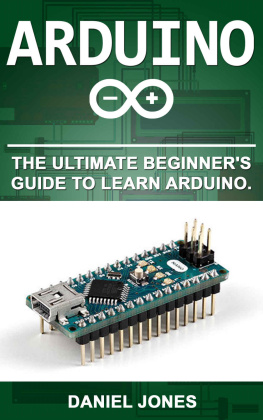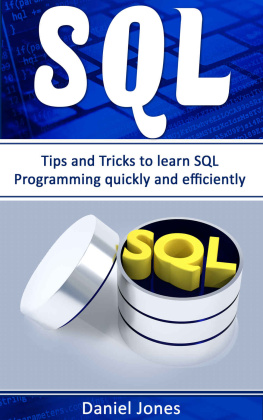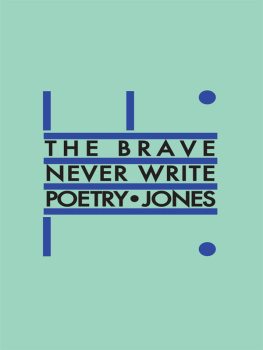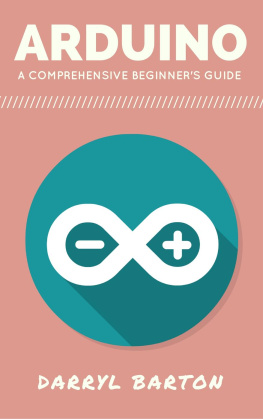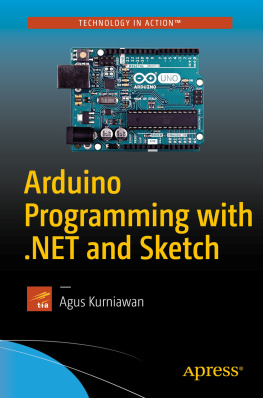Daniel Jones - Arduino: The Ultimate Beginners Guide to Learn Arduino
Here you can read online Daniel Jones - Arduino: The Ultimate Beginners Guide to Learn Arduino full text of the book (entire story) in english for free. Download pdf and epub, get meaning, cover and reviews about this ebook. year: 2017, genre: Computer. Description of the work, (preface) as well as reviews are available. Best literature library LitArk.com created for fans of good reading and offers a wide selection of genres:
Romance novel
Science fiction
Adventure
Detective
Science
History
Home and family
Prose
Art
Politics
Computer
Non-fiction
Religion
Business
Children
Humor
Choose a favorite category and find really read worthwhile books. Enjoy immersion in the world of imagination, feel the emotions of the characters or learn something new for yourself, make an fascinating discovery.
- Book:Arduino: The Ultimate Beginners Guide to Learn Arduino
- Author:
- Genre:
- Year:2017
- Rating:5 / 5
- Favourites:Add to favourites
- Your mark:
- 100
- 1
- 2
- 3
- 4
- 5
Arduino: The Ultimate Beginners Guide to Learn Arduino: summary, description and annotation
We offer to read an annotation, description, summary or preface (depends on what the author of the book "Arduino: The Ultimate Beginners Guide to Learn Arduino" wrote himself). If you haven't found the necessary information about the book — write in the comments, we will try to find it.
Arduino: The Ultimate Beginners Guide to Learn Arduino — read online for free the complete book (whole text) full work
Below is the text of the book, divided by pages. System saving the place of the last page read, allows you to conveniently read the book "Arduino: The Ultimate Beginners Guide to Learn Arduino" online for free, without having to search again every time where you left off. Put a bookmark, and you can go to the page where you finished reading at any time.
Font size:
Interval:
Bookmark:
Arduino:
The Ultimate Beginners Guide to Learn Arduino
Table of Contents
Copyright 2017 by ___ K.M. KASSI ___________________ - All rights reserved.
The follow eBook is reproduced below with the goal of providing information that is as accurate and reliable as possible. Regardless, purchasing this eBook can be seen as consent to the fact that both the publisher and the author of this book are in no way experts on the topics discussed within and that any recommendations or suggestions that are made herein are for entertainment purposes only. Professionals should be consulted as needed prior to undertaking any of the action endorsed herein.
This declaration is deemed fair and valid by both the American Bar Association and the Committee of Publishers Association and is legally binding throughout the United States.
Furthermore, the transmission, duplication or reproduction of any of the following work including specific information will be considered an illegal act irrespective of if it is done electronically or in print. This extends to creating a secondary or tertiary copy of the work or a recorded copy and is only allowed with express written consent from the Publisher. All additional right reserved.
The information in the following pages is broadly considered to be a truthful and accurate account of facts and as such any inattention, use or misuse of the information in question by the reader will render any resulting actions solely under their purview. There are no scenarios in which the publisher or the original author of this work can be in any fashion deemed liable for any hardship or damages that may befall them after undertaking information described herein.
Additionally, the information in the following pages is intended only for informational purposes and should thus be thought of as universal. As befitting its nature, it is presented without assurance regarding its prolonged validity or interim quality. Trademarks that are mentioned are done without written consent and can in no way be considered an endorsement from the trademark holder.
Introduction
Congratulations on downloading Arduino and thank you for doing so.
The following chapters will discuss what you need to understand Arduino and everything that has to go with it. You are going to learn what you need to learn in order to be able to use Arduino in an efficient manner that is going to make it to where when you need to use Arduino on a daily basis, you are going to know how to use it.
There are plenty of books on this subject on the market, thanks again for choosing this one! Every effort was made to ensure it is full of as much useful information as possible, and please enjoy!
Chapter one: What is Arduino?
Arduino is a computer company that works in both the software and hardware that a computer uses. The community that uses Arduino is going to be the ones that design and manufacture the microcontrollers and microcontroller kits that are located on a single board.
The Arduino boards are used to build digital devices as well as other interactive objects that are going to be able to control things in the physical world around us. These products are going to be using an open source hardware as well as an open sourced software that has been licensed under the LGPL (GNU Lesser General Public License) as well as the GPL (GNU General Public License so that the boards can be manufactured and distributed to the public. You can find an Arduino board either preassembled or in a kit that will allow you to build it yourself.
The design of the board is going to vary based on what sort of controllers or microprocessors it will contain. The board is going to be equipped with both digital and analog input and output pins that are going to allow the Arduino board to interact with expansion boards and even other circuits. There is a feature on the Arduino board that allows the communication interfaces to be used. This includes the use of USBs on a few of the Arduino models which will allow for programs to be loaded off of a personal computer.
Arduino's microcontrollers are going to be programmed to use a dialect that is going to use the programming language of C as well as C++. It also uses a compiler toolchain that is more traditional in order to provide an integrated development environment (IDE) that is going to be based on the programming language that it works with.
The Arduino project began in 2003 in Italy initially as a program for the students that were attending the Interaction Design Institute. The purpose of the project was to try and provide an easy and cost-effective way for a novice as well as a professional to be able to create a device that would allow them to interact with the environment around them through the use of actuators and sensors.
Some of the most typical examples of which the devices interact are things such as a thermostat, a motion detector, and even robots.
Arduinos name came from one of the bars that can be found in Ivrea, Italy in which the founders would meet to discuss their ideas. This bar was named after the March of Ivrea and the King of Italy back in 1002 to 1014.
Chapter two: Hardware, Software, and Applications
Being that Arduino is an open source hardware, there are going to reference designs to the hardware that are going to be sent out through the Creative Commons Attribution-Share Alike License which also means that they are available on the Arduino website. The layout and even the production files are going to be available depending on which version you are working with.
Even the source code has been released to the public because of the GNU General Public License. However, an official Bill of Materials for the boards has not and probably will not be published by the staff that works with Arduino.
Despite the fact that the designs for the hardware and software are free, the name Arduino is strictly exclusive to the boards in order to make sure that it cannot be used for any other boards without permission from the company. In fact, the documentation that is in place for the Arduino name specifically says that the project is open to working with others to incorporate them into the official product.
Several products are compatible with Arduino that were released commercially so that they could avoid having other products out on the market with the suffix -duino. A vast majority of the boards are going to have an Atmel 8-bit AVR microcontroller. Which consists of different amounts of pins, flash memory, and various other features. If you are using the 32-but board, then it will work with an Atmel SAM3X8E which was introduced back in 2012. All of the boards are going to use a single or double row of pins that are going to facilitate the connections needed so programs and other circuits can work with it properly.
The boards that you are able to purchase are:
- Arduino RS232
- Arduino Diecimila
- Arduino Duemilanove
- Arduino Uno R2
- Arduino Uno SMD R3
- Arduino Leonardo
- Arduino Pro
- Arduino Mega
- Arduino Nano
- Arduino LilyPad 00
- Arduino Robot
- Arduino Esplora
- Arduino Ethernet
- Arduino Yun
- Arduino Due
Shields
Any Arduino or devices that are compatible will use a circuit expansion board known as a shield that will be able to be plugged into the pin heads. A shield is going to be able to provide the controls that are needed for 3D printing and other applications such as GPS or liquid crystal displays. You even have the option of making your shield.
Software
Any program that is written for Arduino is going to be written in any programming language that you want it to be written in as long as it is able to be produced by a binary machine code for the target processor. The Atmel is going to give you a development environment that will work with the microcontrollers.
Font size:
Interval:
Bookmark:
Similar books «Arduino: The Ultimate Beginners Guide to Learn Arduino»
Look at similar books to Arduino: The Ultimate Beginners Guide to Learn Arduino. We have selected literature similar in name and meaning in the hope of providing readers with more options to find new, interesting, not yet read works.
Discussion, reviews of the book Arduino: The Ultimate Beginners Guide to Learn Arduino and just readers' own opinions. Leave your comments, write what you think about the work, its meaning or the main characters. Specify what exactly you liked and what you didn't like, and why you think so.

